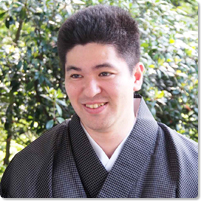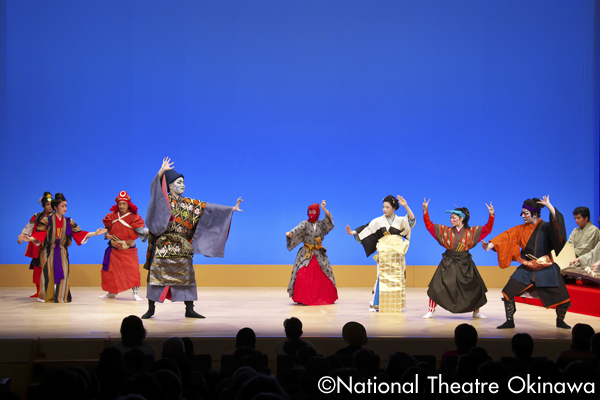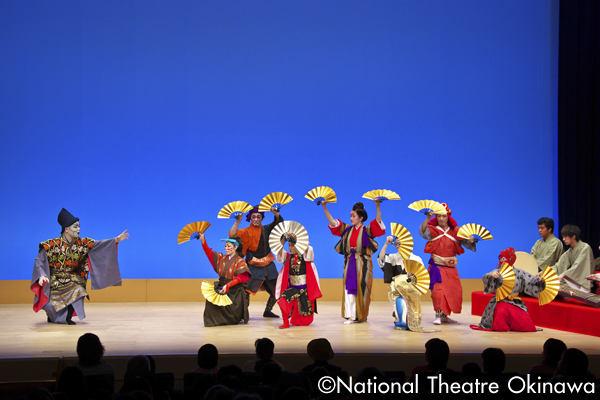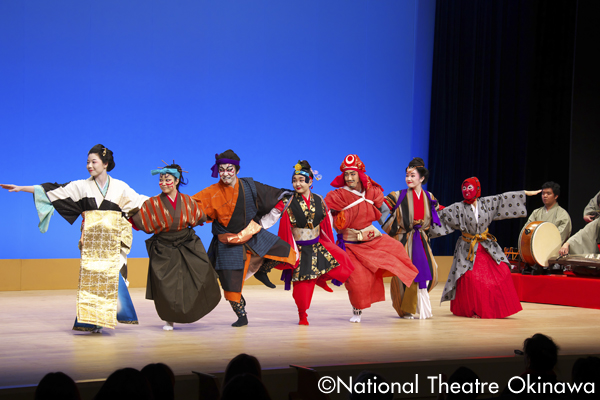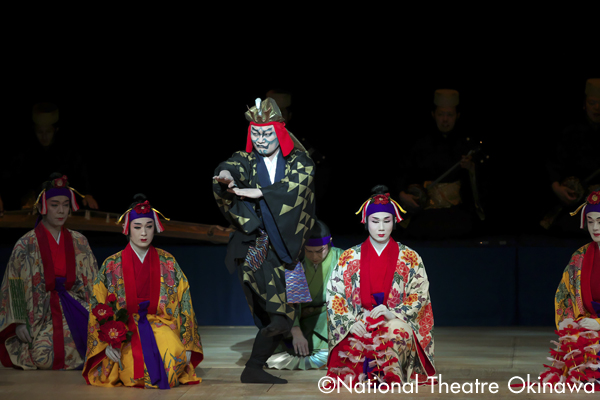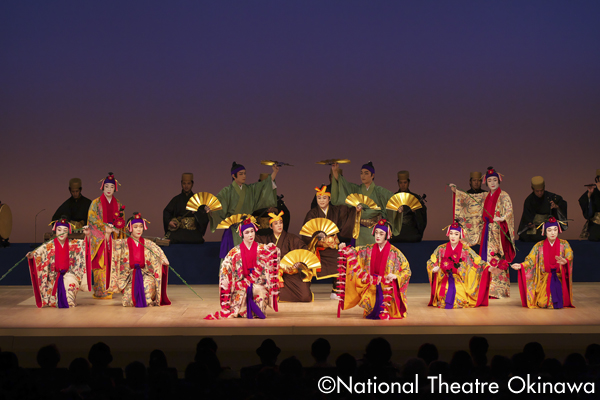- The first artistic director of the National Theatre Okinawa was Ryoshu Koki (born 1938), who can certainly be called a leading authority on Okinawan arts and is known for his activities such as being a founder of the innovative Okinawa Shibai Jikken Gekijo (Okinawa play experimental theater). Having taken over the position of second artistic director at your young age from Koki-san who was in his 70s, you must have felt considerable pressure at first, didn’t you?
- The year before last when I was first offered the job by a representative from the Okinawan government, I couldn’t believe it. The job of artistic director at the Theatre also carries the responsibilities Planning and Production Dept. chief and it makes you very busy. There had been serious worries about asking a man the age of Mr. Koki to carry such a heavy workload considering his physical condition.
I had been performing at the National Theatre Okinawa since the time it opened and I had also had productions of my own work performed there as well as being asked to work at times as an outside director in recent years, so I had long had connections with the Theatre. But, I was still an artist in training and I had no personal connections to speak of. I worried about my ability to take on such an important job, but when my elders and friends of my generation, as well as the younger students, gave me their support, I decided to do my best and try taking on the job despite my lack of experience.
It wasn’t until five years after the opening of the National Theatre Okinawa that the position of artistic director was finally established in 2009. Until then, the role of Planning and Production Dept. chief had been left up to the assigned officer from the prefectural government, but by the fifth year it seems that it was decided that running the Theatre required an artistic director who knew the arts well. If things were allowed to go back to the way they were before Mr. Koki, there was a danger that the directions and progress he had made in building the position of artistic director might be lost. I had been fortunate to be taught by Mr. Koki often since my student days, so when he was kind enough to tell me that he was counting on me to take the job and that it was time for us to begin the necessary work of building a foundation for our new generation, I realized that he was more concerned than anyone about the future direction of the Theatre.
The masters of the Okinawan arts who had been leading us until then were mostly getting along in years as well. I believe the reason I, a person in my thirties, was given this job is that so many people in the Okinawan traditional arts are worried about how these traditions will be passed on to our generation. So, I am determined to work hard in this job with the help of the people around me to look at our traditions and try to establish systems that will enable performing artists like myself to go forward actively with a strong sense of direction. - Would you tell us about the programs you plan for the National Theatre Okinawa?
- At the National Theatre Okinawa we have four basic areas that form the pillars of our programs. They are (1) performances of Kumiodori, traditional Ryukyu dance, traditional Ryukyu music and the like, (2) nurturing the next generation of Kumiodori performers (called tachikata) and music performers (called Jikata), conducting arts surveys/research, collecting and exhibiting materials about the arts and (4) introducing arts from Asia and the Pacific regions that influenced Okinawan arts and arts from the main islands of Japan and encouraging exchanges involving them. We put together our programming based on these and we have 30 productions/performances a year on our schedule. In 2014, we had 19 events on our “regular performance” schedule, six specially planned performance events, four audience-building/outreach performance events and one research event. On our regular performance schedule we have performances not only of the traditional Okinawan classics but also local performing arts from around Okinawa and Okinawa plays (Kabuki or narrative plays created after the Meiji Era). In our specially planned performance events we have revivals of old Kumiodori works and new works to contribute to the development of Kumiodori.
- Would you tell us about the make-up of your Planning and Production Department?
- We have nine people in the department including civil servants from the prefectural government, specialists and part-time staff, but it is difficult to do the production for all of the our programs ourselves with this small number of people, so we commission about ten of the 30 annual programs for outside production.
There are 41 people employed at the National Theatre Okinawa and some of them are regular staff from foundations and the majority are temporary transfers from Okinawa Prefecture or the Japan Arts Council and part-time employees. The temporary transfers are usually transferred out again after three years, so just about the time they get used to the work in the theater they are transferred out, and that is an issue we need to work on in a workplace like a theater, where continuity is so important. - That puts an added burden on the people in the workplace, doesn’t it?
- Yes, and for that reason, I believe that we have to depend a lot on the help of many people in the community. That means not only theater employees but I also want to enlist the help of our seniors in the arts, like Mr. Koki. And, I also want to provide opportunities for young people who want to work in planning and directing.
The program for 2014 was already planned when I came to this job, so I will be serving as artistic director in the full sense from the 2015 program. Basically I will continue things as they have been going and then I want to gradually add new elements. For example, in our audience-building/outreach program we already have a “Kumiodori appreciation classroom for parents and children” and a “Kumiodori appreciation classroom” for adults, middle school and high school students, and I would like to expand this to the arts of Okinawa plays (shibai) and traditional Ryukyu dance.
I also feel the need to establish more tie-ups with halls and theaters inside and outside of Okinawa. If our productions are only shown at our National Theatre Okinawa they usually end with just one performance, but if we can take our productions to other halls it increases the number of on-stage performing opportunities for our performers and also increases our income as well. Once a year we have a “hasshin” (transmitting/outreach) performance program where we take our Okinawan arts to perform for audiences outside of Okinawa which is now in its fourth year, but when we rely solely on the budget from the National Theatre Okinawa it tends to be limited to small-audience lecture type performances. Fortunately, we now get requests from lots of halls outside the prefecture that want to have performances of our traditional Ryukyu dance and music and plays, so I want to work in a direction in which we can tie up with these halls and split the expenses so that we can put on more substantial productions and show these arts properly. - You mentioned the aging of the Okinawa arts. Is this a problem mainly of the aging of the performers?
- There is an aging of the performers but the aging of the audience is also a big issue. If there is no audience the arts won’t survive. Kumiodori is performed in the language of the Ryukyu Kingdom period, so there is a problem of people not going to see it because they don’t understand the contents and what is being said. We have to think about what kinds of approaches we can provide so that people seeing it for the first time can get something out of it and make it more approachable. This is a big issue in terms of growing the audience.
- Much of Kumiodori is performed at a slow pace, and the lines are delivered in a uniquely melodious chant. There is a different flow of time in it that people today are not accustomed to, and I believe that is part of the appeal, but it is also difficult for most to discover that appeal, isn’t it?
- Yes. While some may say that it needs to be made easier for the contemporary audience to understand, there are still things that must not be compromised or lost. That is the fundament essence and the spirit of the art. If you think that Kumiodori should be performed using contemporary Japanese because the original language can’t be understood, I don’t think that is right. There are emotions and expressions in Kumiodori that can’t be expressed in Japanese. That is what I want to preserve. In the movement there are gestures with a particular flavor that has been handed down since the days of the Ryukyu Kingdom. It is not an easy thing but we have to find a good balance between ease of understanding and the things that must not be lost in the tradition.
- When you were studying at Okinawa Prefectural University of Arts, you created a Kumiodori piece for children. You based the story on the children’s book Swimmy by Leo Lionni.
- It premiered in my first year of graduate school, in 2002. In our stage production course we did a workshop with children. There was the doubt that the children would become interested if we did one of the famous classics from the Kumiodori repertoire. Since it is even difficult for adults, it seemed that it would certainly be too difficult for children to enjoy. Personally, I was satisfied doing the classics, so I never felt the desire to try to create a new work, but I felt that the only way to get children interested would be to create a new piece.
I thought about what would be a story that the children knew and would also lend itself well to Kumiodori and what I came up with was Swimmy. The main character is a fish. The little herring whose parents and siblings have been eaten by a shark gets his friends together to get revenge. Many Kumiodori plays are stories of poetic justice, so a story of getting revenge suits the Kumiodori style well. Taking ideas from the book, I made a short play of about ten minutes. In the workshop we first had the children act out that play, and after they became familiar with the rules of Kumiodori we showed them the famous classic Shushin Kaneiri. When they saw the real Kumiodori after having performed the short play themselves, I found that the children were able to enter the world of Kumiodori quite naturally.
After that, I added more each time we performed our new play until we had an introductory Kumiodori piece that was about 45 minutes long, and it is still being used today by Okinawa Prefectural University of Arts graduates to introduce children to Kumiodori. There are even people who first came to like Kumiodori as children in that first workshop and then went on to study it at our university and have performed Swimmy for children themselves. This made me realize the importance of outreach efforts like this. - How did you yourself first become interested in Okinawan arts.
- It was a case of the familiar pattern in Okinawa where the grandparents like the arts and take their grandchildren to performances. There was a little playhouse near our home where I often went with my grandmother to see Okinawa shibai (plays). That was when I was two or three years old. Okinawa shibai plays are performed in the Okinawan dialect called uchinaaguchi, so children don’t understand what the actors are saying. When I would ask my grandmother what an expression meant, she would explain it to me. In theaters where private conversation in the audience is forbidden, I would have been considered noisy and kept from talking, but at the time no one complained.
I became so enthralled in the plays that when I got home I would do impersonations of the actors. I was so into it that my parents decided to have me start learning traditional Ryukyu dance under a teacher at the age of four. From that time on I kept dancing. In junior and senior high school my club activity was kendo (bamboo sword dueling), but I had to leave practice early twice a week to go to my dance lessons. Since there were few boys studying traditional Ryukyu dance, I worried that I might be tease or bullied because of it, but in fact I was able to continue it because of the understanding and support of my teachers, upperclassmen and classmates and throughout those years.
I just loved dancing, and when I learned that Okinawa Prefectural University of Arts offered an Okinawan arts major in the music department, I decided that if I went to college it had to be there. At the time I was thinking that after graduation I would get a job like everyone else and just enjoy dance in my free time. But, in the course of studying at the university I realized that there was an alternative of being paid to dance from the admission fees the audience paid and becoming a professional stage performer by training and perfecting your art as a dancer.
My first encounter with Kumiodori was in my first year at university. Performance Kumiodori was one of the required courses and that is why I first took it. Kumiodori is a slow-moving art with little movement. It also makes little use of facial expression. Instead it is disciplined form of artistic expression utilizing constrained movements performed in rhythm with the melody of the musical accompaniment. As I did it, I experienced a number of moments when I felt that as I performed I fit in perfectly with the accompanists and the other performers and those experiences made me realize the appeal of Kumiodori and get into it more and more. Since there were few other men doing Kumiodori, I was fortunate to have many opportunities to perform on stage and I gradually realized that if I had ever disliked Kumiodori it was simply because I didn’t know anything about it.
Kumiodori was born as a court art of the Ryukyu Kingdom. And, although it is a beautiful and wonderful art, it was originally created as entertainment for the emissaries from the imperial Chinese court when Ryukyu was a vassal country of China and therefore it is also an art that is full of the struggle of our ancestors to please those emissaries. The fruits of their struggle are also part of the appeal of the art. Once I had the opportunity to do a performance based on a comparison with the Noh play Dojoji. What I realized at that time was that the Noh play Dojoji is about pent up resentment and the Kabuki play Kyoga no KoMusume Dojoji is about painful passion of love. However, the Kumiodori classic Shushin Kaneiri is about a man who refrains from love to remain loyal and fulfill his duties. At the heart of it lies the political strategy to present a favorable image of Ryukyu before the emissaries of imperial China. The appeal of Kumiodori lies in the bright good heartedness and humility with which our ancestors faced the great nation of China in order for this small vassal kingdom to survive as an independent kingdom. I feel that this was our ancestors’ gift of support for the future generations of Okinawans. That is what I finally realized. - Now we understand more about the spirit of Kumiodori. Besides Swimmy you have also created other new Kumiodori works, and is this because you feel they are necessary to spread interest in and appreciation of Kumiodori?
- Yes. I came to feel that the classics alone are not enough. In graduate school I chose the Kumiodori Marumun (a short comic skit inserted at intervals in the performance like the Ai-Kyogen comic interludes inserted into Noh performances) as my research subject. I thought that if we had these scenes of “comic relief” in the Kumiodori performances, they might be more enjoyable for the people of the older generation who tended to shy away from Kumiodori. With that in mind, I made the piece Sukunamui no Shishi (Lion of the Sukuna Forest) to perform for my Master’s degree performance in my second year of graduate school.
My graduating class was the ninth of our university, and until then the Master’s degree graduate performances had all been of classics of the traditional repertoire and I thought that people would say it was too early for me to be composing new pieces, but my professor in charge, Noho Miyagi, encouraged me to go ahead with it. - Noho Miyagi-san is designated a Living National Treasure in Kumiodori tachikata (dance) performance, isn’t he?
- That’s correct. The performers of Okinawa also compose (write and choreograph) and perform their own works. There is not a division between directors and performers. Master Noho not only performs Kumiodori and [Okinawa] dance but also creates new works. He is an artist that I respect very much and wish to emulate.
The reason I was fortunate enough to be able to work on creating a new piece was because the upperclassmen who came before us of the ninth graduating class had helped nurture us as inheritors of the traditional arts and had created an atmosphere at our university that looked favorably toward new works. Also, my second year of graduate school was also the year that the National Theatre Okinawa opened and a time when the Akutagawa Prize-winning author Tatsuhiro Oshiro was writing new Kumiodori works one after another and helping to make “New Kumiodori plays” a new genre in itself.
It is difficult to say what constitutes Kumiodori, and it is difficult to draw the line between what is Kumiodori and what becomes New Kumiodori, but in my work Sukunamui no Shishi I took the basic scenario of Beauty and the Beast and moved the setting to Okinawa and used much of the basic traditional methods of while attempting to add something new that doesn’t exist in the traditional classics, female Ai-Kyogen comic relief scenes. In all I created five new Kumiodori, including Izayoi Asagao (16th night morning glory) and a Kumiodori for children based on the folktale Momotaro, and some of these are being performed at the National Theatre Okinawa in repeat performances. With new works there is a lot you can’t know until you actually stage and perform it before an audience, and there is a lot that you will realize from watching the audiences’ reactions. Since plays are something that progress with repeated performances, we are also very fortunate to have the opportunity for repeat performances.
In the past two or three years there have been an increasing number of “New Kumiodori” works being performed, and the number of new original works being presented by Master’s degree candidates in their graduation performances at our university is growing as well. I believe this is essential, not only for the spread of the art but also for the development of Kumiodori as an art performed by people living in today’s world and as an art that moves the contemporary heart, I believe new works are necessary. - When you are creating a new work, do you have any rules for things that you feel will make a work no longer Kumiodori, or things that you absolutely have to include?
- Kumiodori was born in the Ryukyu Kingdom era, so loyalty and filial piety are the main themes. Also it developed as an art performed as entertainment for foreign guests, so the stories always have a happy ending. However, I believe that in new Kumiodori works we can introduce new contemporary themes and I feel that each work can have an ending of a type that is relevant and moving for contemporary audiences. In any case, Kumiodori originated as a form of hospitality for guests, and I believe it is fine if the works retain something of that spirit.
The arts of Okinawa have developed in a variety of forms that fit the temper of the different eras. If we take traditional Okinawa dance as an example, in contrast to the classic dance of the Ryukyu Kingdom era, the Zo-odori that developed in the Meiji Period and after reflected themes from the lives of the common people. Just as there are different genres for different eras, I believe that we can have both classic traditional Kumiodori and a separate genre of New Kumiodori. New Kumiodori still only has a history of about ten years, so it is a genre that will be shaped from now on, I’m sure. - One of the developments that is bringing attention to New Kumiodori is the activities of the Kabuki actor Tamasaburo Bando. For the production Chifuijin Tanjo (The birth of Chifuijin) planned and directed by Tamasaburo-san using an original script by Tatsuhiro Oshiro, Tamasaburo-san used young Okinawan performers, and after it premiered last year at the National Theatre Okinawa and the National Theater in Tokyo, it was staged again this year in Okinawa and Kyoto. This time, you have been involved as director in a production of the new creative dance work Horainushima that premiered and ran for eight days of performances at the Minami-za Theater in Kyoto, which is an unprecedented long run for Kumiodori.
- Performing in collaboration with Tamasaburo-san has been a very fruitful event in terms of both the spread and development of Kumiodori. Audience who don’t usually come for Kumiodori performances came to the National Theatre Okinawa to see Tamasaburo-san perform, and it created a completely different atmosphere at the Theatre. This was a very beneficial development, because this is audience that we want to have seeing and learning about the art of Kumiodori. I will be please if some of these people will now want to come and see Kumiodori even when Tamasaburo-san isn’t performing.
For performers like us, performing on the same stage as such a great artist as Tamasaburo-san has been a truly rewarding and beneficial experience. It was very inspiring to see this great artist who achieved the status of Living National Treasure for his work in Kabuki then come to a completely unfamiliar art such as Kumiodori and learn it and create a work in it and then attempt to put on a good performance for the audience. He showed us the great spirit that he approaches the stage with day by day. For an artist as accomplished as Tamasaburo-san, once he has created a movement or pose, I’m sure it must be easy for him to repeat that pose or movement every day, but he shows how he never compromises and works hard every day to bring his art to a higher level. To be able to work with him on the same stage and see that artistic spirit has been the greatest lesson we, as young performers, have learned from him.
Tamasaburo-san is also a very frank and straightforward person, and when there was a gesture or movement that he didn’t understand, he would ask us, “Why is it done like this?” “What is the reason?” That showed us that the movement we take for granted in our genre will seem unusual for an artist of another genre, and it made us realize that we had been performing these movements without questioning why a particular movement is the way it is. We had been performing things the way we were taught and we were forgetting to question the reasons behind them and to search deeper for their essence.
For the restaging of Chifuijin Tanjo that I was able to participate in the directing of, I added Ai-Kyogen scenes to help make the contents of the story of the play easier to understand. Tamasaburo-san is an artist who knows very well how to show himself on stage and I wanted to bring out that appeal as much as possible, but when there were elements in his performances that went counter to the rules of Kumiodori, I made a point to explain those clearly, and he turned out to be very receptive and flexible regarding this.
This year’s premiere of Horaijma was the result of a suggestion by Tamasaburo-san last year when talking backstage about a possible work if we were to do another production. It takes the solo dance Yanaji from the classical Japanese dance tradition and turns it into a beautifully elaborate group dance, which is an idea that I feel would not have emerged normally in the Okinawan performing arts tradition. But, I feel that it turned out to be a production that showed the potential of Ryukyu arts as seen in the practice of maintaining the basics of Kumiodori while also adding new elements to create a coexistence of the traditional and the new. - In the traditional performing arts of Japan such as Noh and Kabuki, there is no such thing as the “curtain call” that we see in Western opera, but with your performances this time at Minami-za in Kyoto there were curtain calls, and the audience was very enthusiastic in its applause.
- I did have some uncertainty about it because it is not done in traditional performances, but it made me proud to experience it nonetheless. It was something that I wish I could have shown to the many ancestors in the arts that have carried on the Ryukyu traditional arts since the Ryukyu Kingdom era until today. Because, it is thanks to these ancestors in the arts that we are able to perform on stages like this today. From now on, I want to take to heart the things we have learned from Tamasaburo-san and make it our own.I want to see us continue performance activities like this, but longer performance tours will perhaps present a problem. Many of our performers do not make their living solely by performing. They have other jobs and perform on the side. For the eight days of performances at Minami-za these people had to take time off from work, and some who couldn’t get time off had to give up the possibility of coming.
- Okinawa has the image of an “Island of the Performing Arts” where nearly everyone sings and dances or plays the sanshin (three-stringed banjo), so one would think that there are many professional performers. Is it not an environment where people can concentrate on the arts alone as a livelihood?
- The fact that nearly everyone can perform something is in fact part of the problem, because it means that people are not willing to pay money to study an art or pay money to go and see performances. Many performers have made a living by teaching their art, but the number of people taking lessons is now decreasing. Because there are occasions like weddings and other celebrations where people want to perform something, they may go for lessons for four or five months until they learn one piece, but there are few who continue studying long-term. In order to continue performing, most people have to have a job like a part-time instructor at a university of be self-employed or in a flexible job where they can take off time when they want to.
- In August you will be touring five cites in Bolivia and Brazil for performances under a joint production by the Japan Foundation and the National Theatre Okinawa. What do you try to communicate to foreign audiences?
- This time we will tour with an all-male troupe of 11 including the stage director and with a varied program including dance, folksong, music and Okinawan plays (shibai). I want us to communicate our Okinawan arts with pride. Although we do make some modifications to help foreign audiences enjoy the performances more, we do not redo everything on the excuse that it is an overseas performance.
The Okinawan performing arts were influenced by the arts of Japan and China, but they have never stopped at the level of simple imitations of foreign arts. That is due to the commitment of our ancestors who shaped these arts. We should ask ourselves why Kumiodori, which was developed as entertainment for visiting Chinese emissaries, was not performed in Chinese. We are told that the emissaries watched it while reading explanations written in Chinese. It would seem that if the intention was to flatter the Chinese guests, it would have been better to perform for them in Chinese. I believe the reason that they didn’t was surely because of their pride in the beauty of the Ryukyu language and an artistic spirit that would not stoop to flattery. I want to pass on for the future this spirit handed down by our ancestors in the arts, and is something that should be the same overseas, in Japan or in Okinawa.
As the successors to this artistic tradition today, I believe that we are blessed with an excellent environment today. With Okinawa Prefectural University of Arts and programs at the National Theatre Okinawa for nurturing the next generation of performers and Kumiodori training, people can study and learn without the boundaries that have separated the individual traditional schools of the arts. As a result there has been a growth in the number of young male performers coming up. The “Shii no Kai” performance group made up of interested graduates of the National Theatre Okinawa Kumiodori training course has gained strength as performers and become a viable performance group supporting the programs at the Theatre. The inclusion of Kumiodori on the UNESCO list of Intangible Cultural Heritage of Humanity has also brought additional interest in our art. We now have an environment where we can talk together with our shared interest in preserving and developing the Ryukyu performing arts.
What I saw as a child was the plays and dance performances of the elder generation of performers, but today it is young and middle-aged performers who are the central performers on the stage, and we now have children who are looking up to them with admiration. When we have these children who like traditional dance join in our performances in child role, they perform with great zeal. So, now I can be relatively optimistic about having people to carry on the traditions, but the problem is now the audience.
Starting from next year we will be having outreach programs to spread viewing opportunities, including tours to the outlying islands of Okinawa. This will mark the start of my full-fledged activities as artistic director of the National Theatre Okinawa.
Opened in the city of Urazoe, Okinawa in January of 2004, the “National Theatre Okinawa” was established with the mission of preserving and promoting the traditional Okinawan arts such as Kumiodori, which has the status of an Important Intangible Cultural Property of Japan, and to serve as a base for cultural exchange through traditional arts with Asia and the Pacific region. Its facilities include a large theater (632 seats), small theater (255 seats) and studio spaces. Among the Theatre’s programs are a Kumiodori training program (3-year course with studies in six disciplines) aimed at nurturing successors to carry on the Kumiodori tradition. Graduates of the Kumiodori training program now conduct their own activities as the “Shii no Kai” performance group.
https://www.nt-okinawa.or.jp/
Kumiodori
Kumiodori is a form of song and dance theater known as the national theater form of the Ryukyu Kingdom. It was originally created as a form of entertainment for emissary missions called Sakuhoshi sent by the emperor of China to recognize the instatement of the kings of Ryukyu Kingdom. It is credited as a creation of the courtier Odoribugyo Tamagusuku Chokun and was first performed in the front courtyard of the Shuri Palace in 1719 with the performance of two Kumiodori plays titled Nido Tekiuchi and Shushin Kaneiri. Chokun also created Kumiodori plays titled Meikarushi, Onna Monogurui and Koko no Maki, which combine with the first two to constitute the Chokun’s Five Plays (Chokun no Goban).
Taking traditional Ryukyu music and dance as its base, Kumiodori borrowed elements of Japanese Noh and Kabuki theater traditions and was performed by men of the warrior (samurai) class. In 1879, when Japan dissolved the Ryukyu Kingdom and forcibly annexed Okinawa as part of Japan, the warrior (samurai) class that had carried on the Kumiodori tradition was disbanded. During the battle of Okinawa in the Second World War many Okinawans died, including inheritors of the Kumiodori tradition.
Having survived these threats to the continuation of the tradition, Kumiodori was recognized by the Japanese government as an Important Intangible Cultural Property in 1972, the year Okinawa was returned to Japanese governance by the United States, and in 2010 it was added to the UNESCO list of Intangible Cultural Heritage of Humanity.


